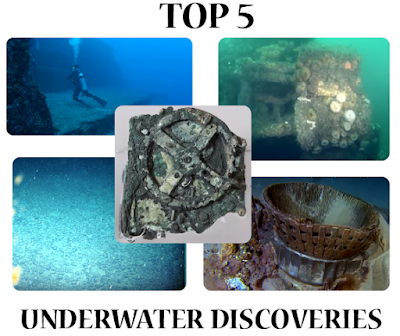5. UNDERWATER TRAIN GRAVEYARD
Archeologists have discovered a train graveyard off the coast of New Jersey, where two rare locomotives from the 1850s lay preserved under 90 feet of water. It remains a mystery how the two steam engines were sunk. There is no historical record of them ever being built and no record of them being lost.Explorers believe that the engines were lost in a storm five miles off the coast of Long Branch, New Jersey, as they were being transported from Boston to the Mid-Atlantic.This graveyard was found by chance by Paul Hepler back in 1985. He was mapping the bottom of the ocean with a magnometer. The device, when over the graveyard, picked up on the two huge metal objects that turned out to be the trains.
4. YONAGUNI MONUMENT
Marine geologist Masaaki Kimura claims that the formations are man-made stepped monoliths.His ideas are disputed and there is debate about whether the site is completely natural, a natural site that has been modified, or a man-made artifact.Neither the Japanese Agency for Cultural Affairs nor the government of Okinawa Prefecture recognise the features as important cultural artifacts and neither government agency has carried out research or preservation work on the site.About 25 meters beneath the waters off Japan lies a stepped pyramid. We don't know who built it, or when; but there it is, plain as day, available for anyone to go down and inspect. Even now at this very minute, the current washes past sharply squared stone blocks standing dark and forbidding, rising nearly high enough to break the surface. It is called the Yonaguni Monument.
3. MANGANESE BALL
Manganese nodules have been found in every ocean, but are most common in the Pacific Ocean. The metal lumps, which most often look like pancakes, are formed of layer upon layer of metal ore that slowly crystallizes around a core. The core may be a fossil, a rock or fragment of another nodule. Nodules vary in size from tiny particles visible only under a microscope to large pellets more than 20 centimetres (8 in) across. However, most nodules are between 3 and 10 cm (1 and 4 in) in diameter, about the size of hen's eggs or potatoes. Their surface textures vary from smooth to rough. They frequently have botryoidal (mammilated or knobby) texture and vary from spherical in shape to typically oblate, sometimes prolate, or are otherwise irregular. The bottom surface, buried in sediment, is generally rougher than the top due to a different type of growth.
2. ANTKYTHERA MECHANISM
For over 2000 years a shipwreck lay off the coast of the Greek island of Antikythera, its hidden treasures slowly corroded by the Mediterranean. It wasn’t until 1900 that sponge divers happened upon the loot, and found therein a perplexing device of remarkable engineering - though the divers had no idea how truly remarkable it was at the time. The device sat in a museum for fifty years before historians began to take a serious look at it.The Antikythera mechanism is one of the world's oldest known geared devices. It has puzzled and intrigued historians of science and technology since its discovery. The device seemed to have a range of interlocking gears made of bronze and a hand crank to give a turning movement to the geared mechanism, plus a display that showed information about the moon, sun and planets against a background of stars. To use the instrument, you would simply enter a date using a crank, and, when the gears stopped spinning, a wealth of information appear at your fingertips: the positions of the Sun, Moon, planets, and stars, the lunar phase, the dates of upcoming solar eclipses, the speed of the Moon through the sky, and even the dates of the Olympic games. Perhaps most impressively, the mechanism’s calendar dial could compensate for the extra quarter-day in the astronomical year by turning the scale back one day every four years. The Julian calendar, which was the first in the region to include leap years, was not introduced until decades after the instrument was built.
1. NASA'S APOLLO 11 ENGINE
The F-1 is a gas-generator cycle rocket engine developed in the United States by Rocketdyne in the late 1950s and used in the Saturn V rocket in the 1960s and early 1970s. Five F-1 engines were used in the S-IC first stage of each Saturn V, which served as the main launch vehicle of the Apollo program. The F-1 remains the most powerful single combustion chamber liquid-propellant rocket engine ever developed.
















0 Comment:
Post a Comment